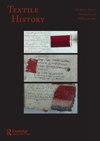都铎王朝的纺织品
IF 0.1
2区 社会学
0 HUMANITIES, MULTIDISCIPLINARY
引用次数: 0
摘要
这本书写得很好,可读性很强的都铎王朝纺织品概述提供了关于这一时期幸存下来的特定物品的良好插图和信息,或者在文献记录中得到了很好的证明,以及当代艺术品中的其他插图。这本书的优势在于在现存的纺织品和其他有关它们的信息来源之间建立了清晰的联系。在这里,林恩作为V&a博物馆前家具策展人的经历以及对皇宫内部的熟悉让人眼前一亮。这里没有针对专业读者的新研究,但它很好地介绍了都铎王朝的纺织品,并严重依赖二手资料——其中一些资料是了解那个时代织物的重要读物。这本书很好地引导了新来者阅读重要书籍,如挂毯上的托马斯·坎贝尔、王室财产清单上的玛丽亚·海沃德和天鹅绒和其他丝绸上的丽莎·蒙纳斯。一些相关研究没有被引用:例如,Caron Penney在《重新发现独角兽挂毯》(2014)中记录了West Dean Tapestry Studios对斯特林城堡的重建工作;苏珊·诺斯(Susan North)对亚麻布进行了早该进行的深入研究(Sweet and Clean,2020)。最后一点有助于解释荷兰不仅是“贵族穿的非常精细的亚麻布”,而且它有不同的品质,经常被列入普通人的遗嘱和清单中。1534年生效的《服装法》(直到1597年,在随后的十项法规中得到重申)明确允许“任何人”进口荷兰等亚麻布。约翰·蒙罗(John Munro)对围巾的宝贵研究(《中世纪围巾与装饰华丽的经济学》,1983年)也被忽视了,这导致了人们对其在整个16世纪继续用于服装的误解。Lena Dahr-en在服装和家具用金银蕾丝生产方面的工作(2010年和2013年)是另一个疏忽。关于“材料和技术”的章节过度简化了一些关键的纺织工艺,但它辅以高质量的插图,包括巴克顿祭坛布的特写照片,这是对那个时代的材料、织物和装饰的有力补充。对纺织品生产的大部分解释都引用了个人接触,而不是同行评审的来源或出版的工艺专家,这在本书最长的部分之一中令人失望。尽管在第一章中提到了“新窗帘”,但与那个时代的纺织品如此相关的羊毛织物和精纺织物之间的区别并没有得到解释。这本书避免了对Kerridge(《现代早期英格兰的纺织厂》,1985年)的依赖,这本书受到了欢迎,因为他密集的尾注经常掩盖了16世纪引用的来源的无关性。许多尾注直接引用了原始来源,这对于证明为王室成员及其亲近者制作的特定纺织品的委托、制造、所有权和“传记”具有特别的价值。关于个人在纺织品收购和欧洲及其他地区贸易扩展中的作用,有一些非常有趣的见解。这本书解释了家具纺织元素的当代术语,如“spever”(床罩),以及刺绣类型的技术术语,例如“slips”(贴花图案),但在安东尼斯·莫尔(Antonis Mor)的肖像中提到了玛丽一世的“裙子”(图124),而巴克顿祭坛布则被称为“裙子”,而不是使用本文章由计算机程序翻译,如有差异,请以英文原文为准。
Tudor Textiles
This well-written, very readable overview of Tudor textiles provides good illustrations and information about specific items that have survived from the period, or are well attested in the documentary record, together with others illustrated in contemporary artworks. The book’s strength lies in drawing clear links between extant textiles and other sources of information about them. Here Lynn’s experience as a former curator of furniture at the V&A Museum and familiarity with royal palace interiors shines through. There is no new research here for specialist readers, but it offers a good introduction to Tudor textiles with a heavy reliance on secondary sources—some of which are essential reading for understanding the fabrics of the era. The book does a good job of signposting newcomers to important texts such as Thomas Campbell on tapestries, Maria Hayward on inventories of royal possessions and Lisa Monnas on velvets and other silks. Some relevant research is not referenced: for example, West Dean Tapestry Studios’ reconstruction work for Stirling Castle has been documented by Caron Penney in Rediscovering the Unicorn Tapestries (2014); and Susan North has taken a long overdue in-depth look at linens (Sweet and Clean, 2020). This last would have been helpful in explaining that holland was not only an ‘exceptionally fine linen worn by the nobility’ but that it came in different qualities and was often listed in the wills and inventories of ordinary people. The Act of Apparel which came into force in 1534 (and was reiterated in ten subsequent regulations up to 1597) specifically permitted imported linen such as holland to ‘any person’. John Munro’s invaluable research on scarlets (‘The Medieval Scarlet and the Economics of Sartorial Splendour’, 1983) is also overlooked, which leads to a misunderstanding about its continued use for clothing throughout the sixteenth century. Lena Dahr en’s work on the production of gold and silver lace for clothing and furnishings (2010 and 2013) is another oversight. The chapter on ‘Materials and Techniques’ over-simplifies some key textile processes, but it is bolstered with high-quality illustrations, including close-up photographs of the Bacton altar cloth, which are a welcome addition to the evidence available for materials, fabrics and embellishments of the era. Personal contacts rather than peerreviewed sources or published craft experts are cited formany of the explanations of textile production, which is disappointing in what is one of the longest sections of the book. The distinction between woollen and worsted fabrics so pertinent to textiles of the era is not explained, although there is a reference to the ‘new draperies’ in chapter 1. The book avoids reliance on Kerridge (Textile Manufactures in Early Modern England, 1985), which is to be welcomed since his dense endnotes often obscure the irrelevance of the sources quoted for the sixteenth century. Many of the endnotes directly refer to original sources and this is of particular value in demonstrating the commission, manufacture, ownership and ‘biography’ of specific textiles made for members of the royal family and those close to them. There are some very interesting insights into individual people’s roles in the acquisitions of textiles and the extension of trade through Europe and far beyond it. The book explains contemporary terms for textile elements of furniture such as a ‘sperver’ (bed canopy) and technical terms for types of embroidery such as ‘slips’ (appliqu ed motifs), but refers to Mary I’s ‘skirt’ in her portrait by Antonis Mor (fig. 124) and the Bacton altar cloth as a purported ‘skirt’ rather than using the
求助全文
通过发布文献求助,成功后即可免费获取论文全文。
去求助
来源期刊

TEXTILE HISTORY
HUMANITIES, MULTIDISCIPLINARY-
CiteScore
1.00
自引率
0.00%
发文量
0
期刊介绍:
Textile History is an internationally recognised, peer reviewed journal and one of the leading publications in its field. It is viewed as an important outlet for current research. Published in the spring and autumn of each year, its remit has always been to facilitate the publication of high-quality research and discussion in all aspects of scholarship arising from the history of textiles and dress. Since its foundation the scope of the journal has been substantially expanded to include articles dealing with aspects of the cultural and social history of apparel and textiles, as well as issues arising from the exhibition, preservation and interpretation of historic textiles or clothing.
 求助内容:
求助内容: 应助结果提醒方式:
应助结果提醒方式:


